The home of Bedford Town Football Club, The Eyrie, Ford End Road, Bedford.
POSTCODE———————————-MK40 4JS
LOCATED————————————About half a mile west of Bedford Railway Station at the bottom of Raleigh Street, just off Ford End Road north of the Queens Footbridge.
ORIGINAL SITE—————————–Allotment Gardens next door to a Gasworks.
DATE CONSTRUCTED——————–Around 1923.
DATE VENUE OPENED——————-Around 1923 as home to Bedford Town Football Club.
Meaning other sports may have taken place prior to the arrival of Greyhound Racing.
FIRST MEETING—————————–During 1971, but meetings had been staged during 1969 under a temporary license.
Greyhound Racing only.
LICENSED OR INDEPENDENT———-Independent
All venues covered would have to be licensed with the government, licensed suggested in this section would refer to tracks operating under NGRC Rules.
INSIDE OR OUTSIDE HARE TYPE——Outside Sumner.
Please note that the Electric Hare suggested is only a guidance and would have been in operation for a certain amount of time at this venue. Although it is not necessarily guaranteed that it was operational all the time, as other types of lure may have been used and updated as time progressed.
DISTANCES———————————–400, 570 and 750 yards.
Please note that most racing venues distances had become varied throughout the years, the ones given above were at once point set and offers only a guidance to the track size.
CIRCUMFERENCE—————————Don’t know.
Please note that alterations at most racing venues throughout its existence would see that the circumference of the track would vary, the one shown above offers only a guidance to the track size.
BIG RACE NAMES—————————Forthprice Derby.
STADIUM SHARED WITH——————Bedford Town Football Club.
LAST MEETING——————————-January 1983.
Greyhound Racing only.
STADIUM CLOSURE DATE—————-January 1983.
Meaning other sports may have taken place after Greyhound Racing had ceased.
STADIUM DEMOLITION——————-1983.
BUILT ON SITE——————————-An extended Industrial area od Wells & Youngs Brewery.
In some cases, structure’s that originally covered the venue after the stadium had been demolished, may have been themselves demolished too, so the one described is more likely to be the one which now presently covers the site.
EVIDENCE LEFT TODAY——————-Some sections of the perimeter wall, and more distinctively, the covered end terrace still exists in the grounds of the Brewery.
FURTHER COMMENTS——————–None
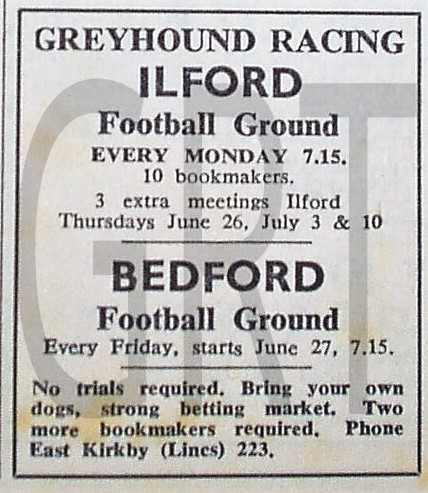
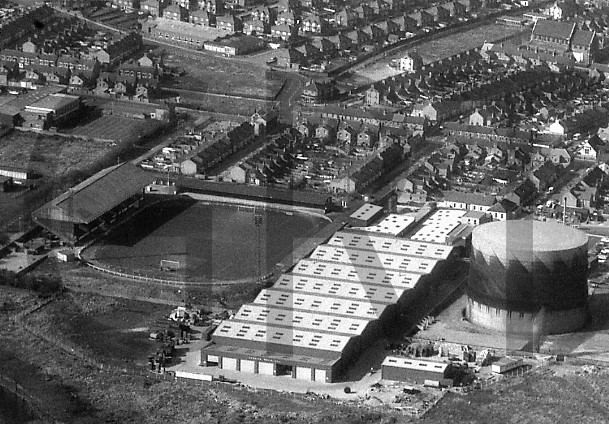






Firstly the lease running out then the Derby cancelled due to shortage of entrants.


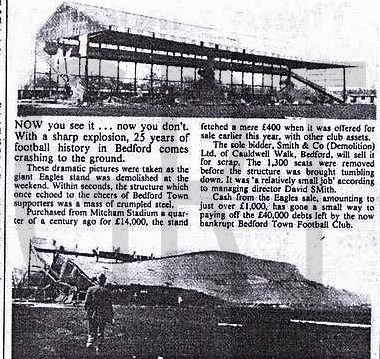
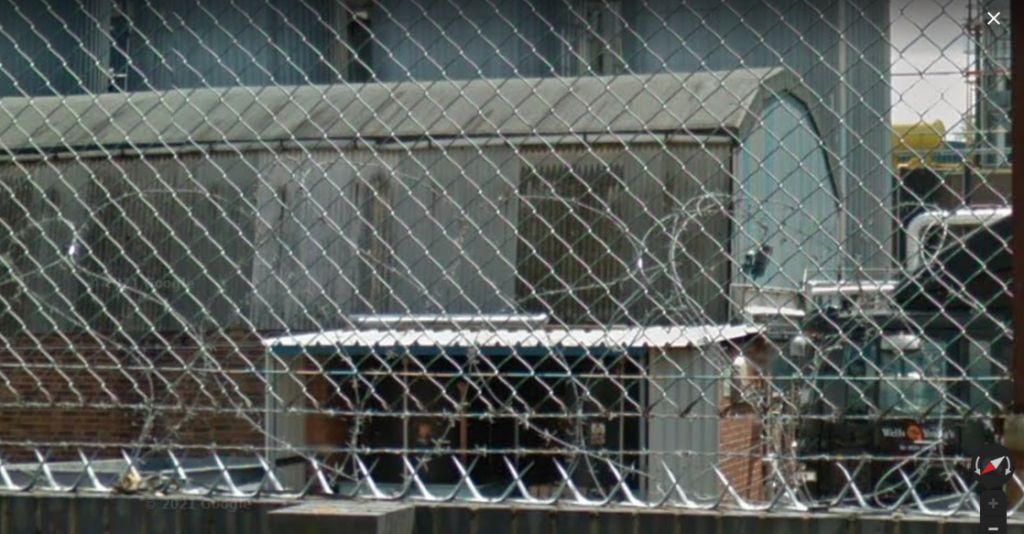
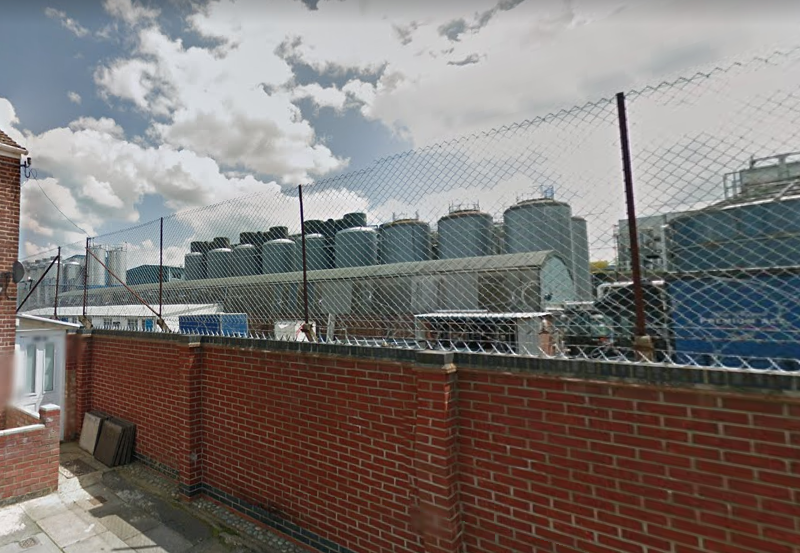
The Eyrie Stadium was the home of Bedford Town Football Club, an impressive non-league football venue, so impressive, that during the 1950’s its excellent facilities could easily have been mistaken for a lower league football ground. The Eyrie began to develop during 1923 on land left behind by a cluster of garden allotments that had lain abandoned under the shadows of two large gas holders. It was situated about a half a mile south west of Bedford’s Railway Station in an area densely populated by housing.
Success in the FA cup during the 1930’s, had put Bedford Town on the map, but it was the post war years that proved a more successful time at The Eyrie. It was during the 1955-56 season that Bedford Town hit the headlines as being FA cup giant killers, firstly by beating Watford in the earlier rounds, and then almost overcame mighty Arsenal in a replay, only to be beaten by two late goals. The revenue generated helped to purchase a huge 1300 seated stand from the Mitcham Stadium in South London. It had cost the club over £14,000, to buy, dismantle, transport and erect the newly christened Eagles Stand, before witnessing its grand opening during 1956. More success followed in the FA cup, with wins over Newcastle and Carlisle, and also a ground record attendance of 18,047 being set against Everton in 1965.
Yet it was the late 1960’s that The Eyrie witnessed its first glimpse of greyhound racing, with a track being laid around the playing pitch, after obtaining a temporary license which allowed its promoters to run just eight meetings each year. In 1971 a more permanent license was obtained by the tracks promoters, making Bedford another addition to the UK’s flapping track list. Once the outside Sumner hare system had been installed, events began with six greyhounds contesting over distances of 400, 570 and 750 yards. The earlier years had seen races run on a grass circuit, but by the late 1970’s the grass was replaced by the more advanced silicon type sand.
By 1979 greyhound racing at The Eyrie had clearly become a profitable indeed, with the annual turnover exceeding the £10,000 mark, which clearly overshadowed the £4,000 turnover generated by the football club and came as no surprise when it was announced that the club was more than £30,000 in debt.
Bedford’s big race attraction was the Forthprice Derby, named after the track’s promoters, who ran the event over the 400-metre trip during September, but a poor response in entries failed to see the running of the event in 1982. By the early 1980’s decision time was on the horizon for both football and greyhound promoters, knowing that the lease for The Eyrie Stadium was about to run out in May 1983. With this in mind, enquiries had been made to find another venue, but sadly all efforts came to nothing.
In January 1983, with four months of the lease still to run, disaster struck, as it was announced that the football club had gone into administration with debts amounting to over £40,000. Almost immediately the brewery, the venue’s owners, announced that no further sporting activities would take place at The Eyrie. Approaches were made to continue greyhound racing, but because the brewery required extra storage space, it became clear it was never going to happen.
Within weeks of closure, the whole venue including structures and fittings went up for auction. The massive Eagles stand was sold to a demolition company for £400 as scrap, with all the other items, like the turnstiles, goalposts etc, were snapped up by other non-league football clubs. The auction raised just £1120, way short of the £40,000 owed by the football club. Demolition began during April 1983, and almost instantly the brewery used the site to store its products. New buildings were erected on newly laid foundations, and soon any evidence of The Eyrie began to disappear.
Today, luckily enough part of the stadium still exists, Some of the perimeter wall still remains at the bottom of Raleigh Street, and to the north of the Queens Footbridge, which crosses the nearby River Ouse. But more distinctively is the covered end terrace, which lays within the grounds of the Brewery still serving the company as a storage depot.
A programme, photograph or even memorabilia for this track is required for this page, if you can help please contact me.

Recent Comments